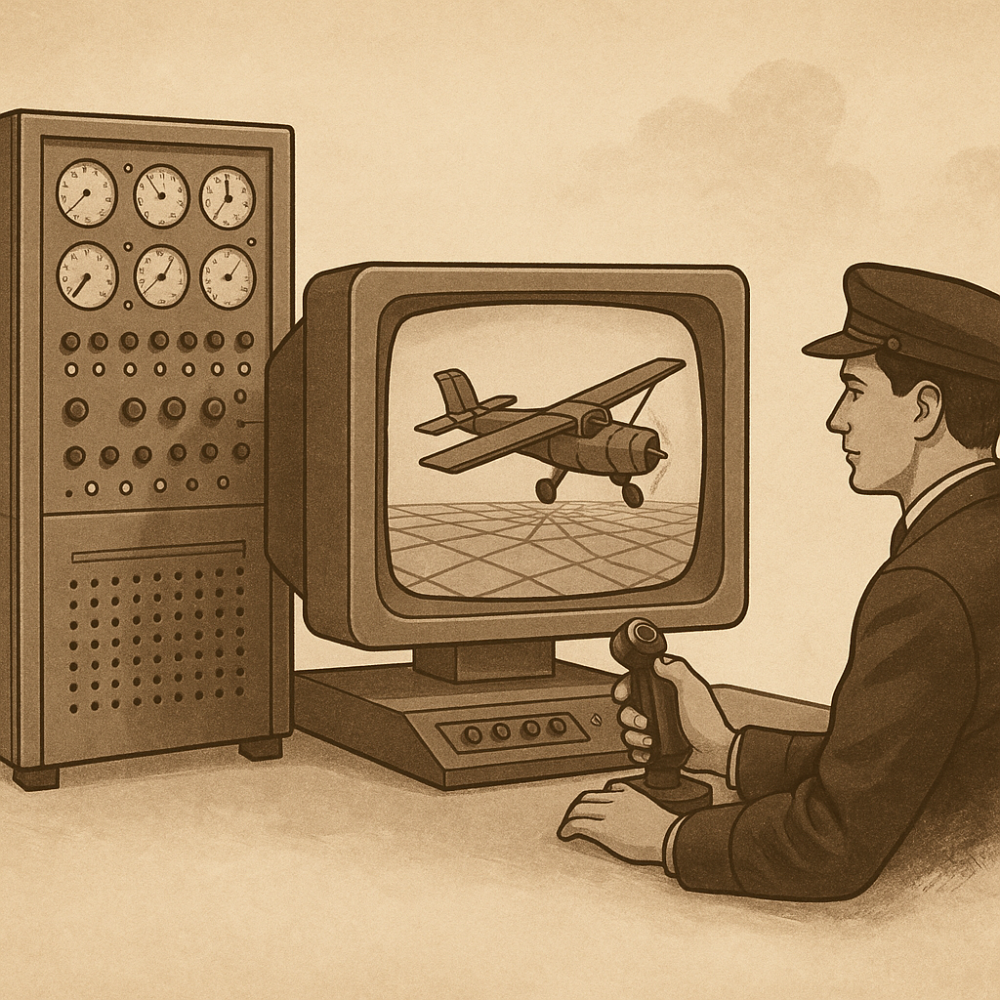Last updated on September 16th, 2025 at 10:23 pm

Flight simulators have evolved from simple training aids to essential tools at the heart of modern aviation. But this isn’t just a tale of machines—it’s a story of innovation, creativity, and our relentless drive to improve how pilots train. Over time, these virtual skies have become key to safer, smarter aviation worldwide.
In the early days, simulators were essential for pilot training, creating a safe environment to practice without leaving the ground. This was crucial back then when the aviation industry was still in its infancy. Today, simulators are central to pilot training programs globally, allowing pilots to experience all kinds of scenarios without real-world risks.
Technology has been the engine behind the evolution of flight simulators—pushing them from basic mechanical rigs to today’s ultra-realistic digital systems. What began with wooden barrels has now become fully immersive environments powered by satellite data, AI, and real-time weather systems.
Tracking the evolution of flight simulation reveals just how much innovation has shaped the journey. From early pneumatic systems to the real-time digital processing we see today, every leap forward has made pilot training more accessible, immersive, and effective.
We’ll explore each major milestone in this field, offering insights into how each innovation built on the last. This isn’t just about planes and pilots; it’s a testament to human ingenuity and our constant push toward the sky. The world of flight simulation is a perfect example of how technology can create more than just virtual reality—it creates a better, safer reality.
The Dawn of Flight Simulation: Early Innovations (1910-1930s)

Flight simulation began as an imaginative journey, born out of necessity rather than luxury. Back in the early 1910s, aviation was still learning to fly, both literally and figuratively. Pilots needed a way to hone their skills before taking to the skies, and that’s where the first rudimentary simulators came into play.
These early contraptions were far from the high-tech setups we’re used to today. Picture wooden mock-cockpits, sometimes built from old barrels—simple yet effective in their mission. They relied on manual manipulation to simulate basic flight movements like pitch and roll. Think of it as a hands-on approach to understanding the very basics of flying.
Then came the game-changer of the 1930s, the Link Trainer. Edwin Link, an aviation enthusiast with a background in piano-building, had a stroke of genius—using pneumatic bellows and perforated tape to mimic flight dynamics more realistically. This was the world’s first automatic flight simulator, fundamentally transforming how pilots trained. For more historical detail, see the RAF Museum’s page on synthetic trainers.
The Link Trainer soon became a staple in flight schools and military pilot training across the globe. Suddenly, pilots could train in any weather, and practice maneuvers safely on the ground. These innovations laid the groundwork for every leap that followed.
This wasn’t just an upgrade; it was a revolution. The Link Trainer soon became a staple in flight schools and military training across the globe. It provided pilots with a reliable way to experience flight conditions safely on the ground. Suddenly, training could happen in any weather, and pilots could practice mid-air maneuvers without leaving the ground.
These groundbreaking advancements laid the foundation for everything that followed. They taught us that with a bit of ingenuity and creativity, we could turn a few planks of wood into a pivotal tool for aviation development. This era was all about setting the stage for the exciting technological leaps that came next in the evolution of flight simulations.
Revolutionizing Reality: The Digital Leap (1950s–1970s)

The transition to digital was a pivotal moment for flight simulators. Before computers became a part of the mix, simulators were mechanical wonders, but they lacked the depth and complexity needed for advanced pilot training. Enter the era of digital computing, which opened up a whole new world of possibilities.
During the 1950s and 60s, the aviation industry was buzzing with excitement about the potential of computers. These machines could process real-time flights, offering unprecedented detail and accuracy. No longer was simulation just about basic maneuvers; now, it was about creating a richer, more immersive flying experience.
We have pioneers like Bruce Artwick, who truly pushed the boundaries. In the late 1970s, Artwick founded Sublogic and championed the arrival of computer-based flight simulation with 3D graphics. This was revolutionary as it allowed pilots to experience a more lifelike flying environment on a computer screen, setting the stage for the larger-scale simulators that would follow. Learn more on the version history of MS Flight Simulator via Flight Simulator History.
The introduction of 3D graphics wasn’t just a display upgrade; it introduced pilots to new levels of depth and realism never before experienced. This was vital for pilot preparation as it provided insights into visual flight references and decision-making processes.
Artwick’s contributions laid the groundwork for commercial flight simulators and sparked a broader interest in flight simulation as a hobby, as well. People could now immerse themselves in the flying experience without actually being in an aircraft.
This era marked a turning point—flight simulators were no longer just training tools; they became central to how pilots prepared for real-world flying. With each tech breakthrough, the vision grew bolder, laying the groundwork for the powerful, immersive platforms we rely on today.
✈️ If you’re new to this world and want to explore the software side of flight simming, check out: 👉 Essential Software and Tools for Novice Pilots.
Mainstreaming Simulations: Microsoft and Rapid Advances (1982-2006)

The 1980s marked a thrilling new chapter for flight simulators, with Microsoft’s entry into the scene in 1982 acting as a huge catalyst. What started as a hobbyist project by Bruce Artwick quickly transformed into a mass-market phenomenon when Microsoft launched Flight Simulator 1.0. This release was a major milestone that brought flight simulation into mainstream consciousness.
Throughout the ’80s and ’90s, Microsoft’s relentless innovation kept enhancing the simulator experience. Each new version raised the bar. FS2 in 1984 brought joystick support and expanded US scenery, while FS3 in 1988 introduced EGA graphics with multiple views, ensuring the simulations felt richer.
By the late ’80s and early ’90s, realism was the name of the game. FS4 initiated dynamic scenery and random weather changes, engaging users with an ever-changing environment. The introduction of textures and satellite imagery with FS5 in 1993 and 5.1 in 1995 took visual realism even further, setting a high standard for future releases, offering users a virtual world that was detailed and unpredictable.
Moving into the Windows era, FS95 capitalized on better graphics, more aircraft, and packed more content than its predecessors. FS98 followed and invited users into a world where 3D acceleration and force-feedback joysticks became the norm, providing an intuitive touch to flying.
Major versions in the early 2000s expanded the game’s horizons with groundbreaking features. FS2000 made its mark with 3D elevation and real-world weather effects like rain and snow. FS2002 introduced AI aircraft and ATC communication, becoming increasingly sophisticated. The iconic FS2004 celebrated a century of flight with 3D clouds and historical aircraft, further cementing Microsoft’s authority in this niche.
With each release, Microsoft not only improved technical aspects but also grew a passionate community around flight simulation. These updates reflected a commitment to capturing the true essence of flying, making it accessible to enthusiasts and professionals alike, all while pushing the boundaries of what’s possible in the virtual skies.
🔍 Want to see how this era compares to today’s tech? Check out:
👉 Comparing Flight Simulator X and Flight Simulator 2020
Modern Flight Simulators: Merging Technology and Realism (2006 – Present)

When Microsoft launched FSX in 2006, it marked a defining moment for the future of flight simulation. This version stepped up with enhanced graphics, multiplayer capabilities, and an open platform for developers, paving the way for a new era of flight simulation.
FSX laid the foundation for derivative platforms like Lockheed Martin’s Prepar3D and Dovetail’s Flight Sim World, each building on its predecessors with even more customizable and detailed experiences. These platforms catered to a dedicated community that valued realism and accuracy, emphasizing aspects like complex weather systems and AI.
Microsoft raised the stakes once again with the release of Flight Simulator 2020. By leveraging satellite data and Microsoft’s Azure AI, it offered stunningly detailed planet-scale environments. This made it possible for pilots to fly over their hometowns and explore the world with unparalleled detail—realism achieved like never before.
With photogrammetry for over 500 cities and weather systems that mirror real-world conditions, Microsoft Flight Simulator 2020 brought the world to life like never before. Add in ultra-detailed cockpits, handcrafted airports, and shifting skies, and suddenly, flying from your desk felt surprisingly close to the real thing.
Looking further ahead, Microsoft Flight Simulator 2024 promises even more advances, including cloud-hosted content for optimal performance and new career modes to challenge pilots. These continuous advancements reflect a commitment not just to technological progress but to delivering a flight experience that’s ever more immersive and engaging.
Flight simulation has come a long way since its early days of wooden contraptions and mechanical trainers. These modern platforms are a testament to how far technology has come, providing everyone from hobbyists to commercial pilots with an invaluable tool for learning, training, and adventure.
🧠 Want to see how flight simulators help real pilots train smarter?
👉 How Realistic Flight Simulators Enhance Pilot Training
✈️ Final Thoughts
The journey from wooden mockups to cloud-rendered global environments is more than a tech story—it’s a story of how flight simulators have become a bridge between the virtual and the real. Whether you’re a beginner, a hobbyist, or an aspiring pilot, flight sims today offer unmatched value in both learning and entertainment.
➡️ Ready to take your flight sim experience to the next level?
Start by checking out our guides on hardware, training tools, and custom setups:
👉 Getting Started with Flight Simulation: A Step-by-Step Guide

Awesome article ! Flight simulation has come such a long way since the 1910s. Thank you for an interesting read.
Thanks a lot for your nice feedback, Elsy! It’s incredible to see how flight simulation has evolved from mechanical trainers in the early 1900s to today’s detailed virtual cockpits.